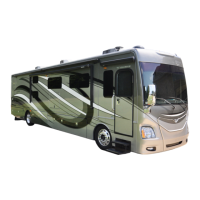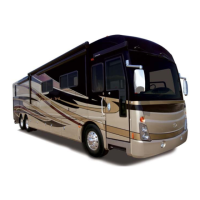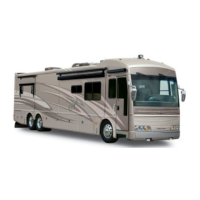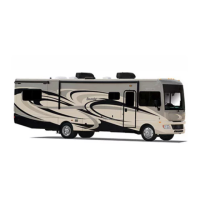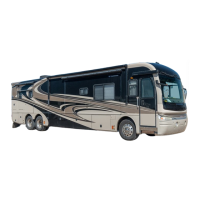Do you have a question about the Fleetwood EXPEDITION and is the answer not in the manual?
Explains the meaning of Warning, Caution, and Note statements used in the manual.
Emphasizes the importance of consistent inspection and maintenance for safety and comfort.
Details the valuable documents included about the motor home and its systems.
Explains the VIN and FIN used to identify the vehicle and components.
Discusses factory alignment and the owner's responsibility for post-delivery alignment.
Warns that unauthorized steering aid devices may void the chassis manufacturer's warranty.
Provides critical safety information for operating the motor home.
Guides on the handling characteristics of the motor home due to its size and weight.
Provides guidelines and warnings regarding towing vehicles or trailers behind the motor home.
Advises consulting professionals for alterations affecting handling and safety.
Highlights the importance of checking and maintaining warning devices for safety.
Explains capabilities of electronic modules for recording vehicle and driver data.
Details what is covered under the warranty for materials and workmanship.
Outlines owner responsibilities for maintenance and warranty claims.
Specifies the dealer's responsibilities for predelivery inspection and defect correction.
Advises on steps to take if the dealer cannot resolve a warranty issue.
Explains the manufacturer's role in repairing or replacing defective parts.
Lists exclusions from the warranty, including chassis and normal wear.
Explains the comprehensive warranty program and owner/dealer rights and obligations.
Provides guidance on obtaining warranty service and preparing for repairs.
Instructs on reporting potential safety defects to NHTSA and Fleetwood.
Provides warnings regarding urea-formaldehyde resin and its potential health effects.
Warns against storing flammable liquids like LP gas containers or gasoline inside the vehicle.
Emphasizes safety precautions for LP gas containers and usage, including overfilling.
Lists interior and exterior bulb types and specifications for replacement.
Identifies and explains the functions of controls on the driver's and passenger's armrests.
Details the various controls on the dashboard, including climate and audio systems.
Explains the importance of proper loading and defines key weight terms like GVWR and GCWR.
Provides guidelines for safe towing, including weight limits and hitch requirements.
Covers tire selection, maintenance, age, and inspection recommendations.
Details the importance of proper tire inflation for safety, performance, and tire life.
Explains the critical role of air pressure in tire life, safety, and vehicle handling.
Describes the dangers and potential damage caused by underinflated tires.
Provides a schedule for checking tire air pressure to ensure safety and longevity.
Specifies requirements for replacing tires, including size, type, and load capacity.
Offers immediate steps to take in case of a sudden tire failure.
Advises on obtaining professional help for changing a flat tire due to vehicle weight.
Explains the function and proper use of seat belts and air bag systems for passenger safety.
Discusses how driving techniques differ for a motor home compared to a car.
Details the diesel engine's characteristics and proper operation to avoid damage.
Provides instructions for normal starting procedures and engine warm-up.
Explains the use and benefits of the engine block heater for cold-weather starting.
Outlines the correct procedure for shutting down the engine and parking the vehicle.
Details the automatic transmission's operation, including manual shifting and check trans light.
Explains the function of the push-button shift selector and digital display.
Describes the purpose and indication of the 'check trans' light.
Explains the function of the compression brake as a slowing device, not a stopping one.
Introduces the air brake system, its components, and pedal operation.
Explains how brake pedal pressure relates to air pressure and braking force.
Details the function of the light/buzzer indicating low air brake system pressure.
Provides guidance on using air brakes for normal and emergency stops.
Highlights the added delay in air brakes and the resulting increase in stopping distance.
Advises on using lower gears for downhill slowing to prevent brake overheating.
Explains the operation of the parking brake and precautions for use.
Describes how to use engine braking for speed control, especially on downgrades.
Explains the function of the air suspension system and its components.
Provides safety tips for maneuvering the large vehicle in traffic, considering its dimensions.
Explains the purpose of undercoating and its application to chassis components.
Advises consulting the chassis manual for fuel recommendations and system precautions.
Explains engine fan operation and noise, noting it is normal under load.
Discusses the heat generated by the engine and exhaust systems and the role of heat shields.
Explains how engine temperature gauges work and how to interpret readings.
Details the dangers of carbon monoxide and precautions to prevent poisoning.
Instructs on the function, testing, and maintenance of the CO detector/alarm.
Provides information needed for emergency towing and preferred towing methods.
Explains the operation of the hydraulic leveling system and safety warnings.
Details the air dump system used to deflate suspension air bags for leveling.
Describes the operation and features of the power entry step.
Provides instructions for operating and securing the main and screen doors.
Guides on operating slider and torque pane windows, and maintaining weep slots.
Explains the operation of emergency exit windows for escape purposes.
Details the operation of power mirrors and manual adjustment if not equipped.
Describes the function and adjustment of sun visors for glare reduction.
Explains the controls for power sun visors and their proper positioning.
Provides instructions on how to raise, lower, and adjust window shades.
Explains the dual-purpose operation of day/night shades for privacy and light control.
Details the procedure for raising, lowering, and adjusting mini-blinds.
Covers exterior storage compartments, their locking mechanisms, and loading considerations.
Guides on accessing and using interior closets, cabinets, and drawers.
Explains the operation and safety precautions for slide-out rooms.
Discusses the materials used for interior furnishings and their care requirements.
Provides instructions for converting the dinette area into a bed.
Details how to convert sofas into beds and restore them to lounge positions.
Highlights the need to secure free-standing furniture during travel for safety.
Explains the function of dividers and how to secure them for travel.
Describes the types of interior lighting fixtures and their operation.
Guides on operating overhead vents, their fans, and cleaning them.
Advises on storing folding chairs and warns against sitting on them while the vehicle is in motion.
Explains how to check tank levels and battery charge using the monitor panel.
Discusses managing humidity and condensation within the RV environment.
Provides answers to common questions about condensation and offers control strategies.
Explains that dripping from ceiling vents is often condensation, not roof leaks.
Defines mold, its growth requirements, and potential sources within an RV.
Offers steps owners can take to reduce mold growth and prevent moisture issues.
Highlights the importance of fire safety practices and recognizing fire hazards.
Lists suggestions for preventing fires and actions to take in case of a fire.
Explains the operation, testing, and maintenance of the smoke detector/alarm.
Covers the availability of potable water via city hookup or onboard storage.
Details how to connect to pressurized city water supply and disconnect safely.
Explains the two methods for filling the fresh water tank: city pressure or gravity.
Provides instructions for draining the fresh water tank before travel or storage.
Describes the self-priming 12-volt DC water pump operation and its protection.
Details the function, cleaning, and servicing of the water pump filter.
Instructions for draining hot and cold water lines using low point drains.
Addresses common water system issues caused by vibration, neglect, or pressure variations.
Guides on identifying and repairing leaks in the plumbing system.
Provides a procedure for sanitizing the water system using a chlorine solution.
Instructions for operating the exterior shower and closing valves after use.
Explains the function of the filter system and its maintenance requirements.
Describes the waste water system, including gray and black water tanks and their function.
Details the operation of the marine-type toilet and tips for reducing odors.
Provides step-by-step instructions for draining black and gray water holding tanks.
Explains how to operate the black water tank flush system for residue removal.
Offers considerations for preventing clogging issues in holding tanks.
Outlines the components of the vehicle's electrical system, including battery and ignition.
Describes the 12-volt system for interior lighting, pumps, and accessories powered by house batteries.
Explains the two battery systems and the function of the battery disconnect.
Provides guidance on inspecting, cleaning, and maintaining the vehicle's batteries.
Details battery charging methods and safety precautions.
Advises on choosing the correct replacement battery with matching specifications.
Explains how to use the auxiliary start system to start the engine with the house battery.
Covers the 120-volt AC system, including the generator and power cord.
Details the power inverter's function, capacity, and limitations.
Explains the power converter's role in supplying 12-volt DC power and charging batteries.
Describes the GFCI's function in protecting against electrical shock hazards.
Introduces the diesel generator for self-contained electrical power.
Provides instructions for starting and stopping the generator.
Lists safety guidelines for operating the generator, including ventilation and fuel handling.
Explains the Smart EMS's function in managing electrical loads and preventing breaker trips.
Locates and explains the purpose of fuse and circuit breaker panels.
Details the location and procedure for remotely filling the LP gas tank.
Provides essential safety guidelines for handling and using LP gas.
Introduces the main components of the LP gas system, including hoses and regulators.
Outlines procedures for visually checking the LP gas system for leaks and proper function.
Explains the function, testing, and power source of the LP gas leak detector/alarm.
Provides guidance on lighting LP gas appliances and purging air from the system.
Details the use of accessory LP gas supply devices for outdoor purposes.
Explains the operation of the water heater on LP gas or 120-volt AC power.
Describes the function of the bypass valve for winterizing and normal flow.
Provides operating instructions for the refrigerator, emphasizing leveling and temperature.
Details the forced-air furnace operation and temperature setting via thermostat.
Covers the basic operation of the gas oven and burners, similar to a home range.
Explains the function of the exhaust hood for venting and cleaning the grease filter.
Describes the operation of roof-mounted heat pumps for cooling and heating.
Details the operation of roof-mounted air conditioners, requiring 120-volt AC power.
Explains how video equipment operates from inverter or 120-volt AC power.
Describes the video switcher used for routing signals to front and rear TVs.
Details the video control center for routing signals and recording to VCR.
Explains the roof-mounted antenna's function and the importance of lowering it for travel.
Provides steps for raising, rotating, and lowering the TV antenna.
Describes the satellite dish antenna for receiving digital TV signals.
Identifies the location of the telephone jack and park connection point.
Explains the microwave oven's power source and its wall receptacle location.
Provides instructions for installing a dryer-ready option, focusing on exhaust duct requirements.
Covers additional appliances that operate on 120-volt power and selector switches.
Discusses fiberglass care, including washing, waxing, and protection from weathering.
Provides methods for removing water-soluble and non-water-soluble stains.
Offers guidelines for cleaning and maintaining exterior graphics to keep them looking new.
Covers maintenance for hinges, latches, seals, and cleaning of screens.
Explains how to clean and care for the TPO roof material.
Outlines procedures for inspecting and resealing to maintain weatherproof integrity.
Guides on inspecting and resealing areas prone to leaks or sealant failure.
Provides cleaning instructions for acrylic assist handles, recommending mild soap and water.
Discusses care for interior fabrics, including dry cleaning and spot cleaning methods.
Details the simple care required for solid surface countertops.
Provides cleaning instructions for laminate surfaces using mild dishwashing liquid.
Guides on cleaning walls and ceiling panels without saturating the material.
Advises on methods for attaching accessories to interior and exterior walls.
Recommends approved cleaners for the shower stall to prevent discoloration and brittleness.
Covers maintenance for vinyl flooring, carpeting, and wood floors.
Provides care instructions for wood floors, warning against water and certain cleaners.
Explains how to access the engine from inside the motor home and safety precautions.
Recommends consulting a dealer for current sealant usage information.
Advises consulting the dealer or service directory for generator filter information.
Provides a diagram and labels for trailer hitch connector wiring.
Presents a schedule for various maintenance tasks, categorized by frequency.
Provides checklists for preparing the motor home for short-term and long-term storage.
Lists steps for preparing the motor home for storage periods under 60 days.
Details procedures for preparing the motor home for extended storage periods.
Offers guidance on winterizing the motor home to prevent equipment failure and damage.
Provides comprehensive steps for winterizing the RV water system using antifreeze.
Guides on the procedures for bringing the motor home back into service after storage.
Explains the meaning of Warning, Caution, and Note statements used in the manual.
Emphasizes the importance of consistent inspection and maintenance for safety and comfort.
Details the valuable documents included about the motor home and its systems.
Explains the VIN and FIN used to identify the vehicle and components.
Discusses factory alignment and the owner's responsibility for post-delivery alignment.
Warns that unauthorized steering aid devices may void the chassis manufacturer's warranty.
Provides critical safety information for operating the motor home.
Guides on the handling characteristics of the motor home due to its size and weight.
Provides guidelines and warnings regarding towing vehicles or trailers behind the motor home.
Advises consulting professionals for alterations affecting handling and safety.
Highlights the importance of checking and maintaining warning devices for safety.
Explains capabilities of electronic modules for recording vehicle and driver data.
Details what is covered under the warranty for materials and workmanship.
Outlines owner responsibilities for maintenance and warranty claims.
Specifies the dealer's responsibilities for predelivery inspection and defect correction.
Advises on steps to take if the dealer cannot resolve a warranty issue.
Explains the manufacturer's role in repairing or replacing defective parts.
Lists exclusions from the warranty, including chassis and normal wear.
Explains the comprehensive warranty program and owner/dealer rights and obligations.
Provides guidance on obtaining warranty service and preparing for repairs.
Instructs on reporting potential safety defects to NHTSA and Fleetwood.
Provides warnings regarding urea-formaldehyde resin and its potential health effects.
Warns against storing flammable liquids like LP gas containers or gasoline inside the vehicle.
Emphasizes safety precautions for LP gas containers and usage, including overfilling.
Lists interior and exterior bulb types and specifications for replacement.
Identifies and explains the functions of controls on the driver's and passenger's armrests.
Details the various controls on the dashboard, including climate and audio systems.
Explains the importance of proper loading and defines key weight terms like GVWR and GCWR.
Provides guidelines for safe towing, including weight limits and hitch requirements.
Covers tire selection, maintenance, age, and inspection recommendations.
Details the importance of proper tire inflation for safety, performance, and tire life.
Explains the critical role of air pressure in tire life, safety, and vehicle handling.
Describes the dangers and potential damage caused by underinflated tires.
Provides a schedule for checking tire air pressure to ensure safety and longevity.
Specifies requirements for replacing tires, including size, type, and load capacity.
Offers immediate steps to take in case of a sudden tire failure.
Advises on obtaining professional help for changing a flat tire due to vehicle weight.
Explains the function and proper use of seat belts and air bag systems for passenger safety.
Discusses how driving techniques differ for a motor home compared to a car.
Details the diesel engine's characteristics and proper operation to avoid damage.
Provides instructions for normal starting procedures and engine warm-up.
Explains the use and benefits of the engine block heater for cold-weather starting.
Outlines the correct procedure for shutting down the engine and parking the vehicle.
Details the automatic transmission's operation, including manual shifting and check trans light.
Explains the function of the push-button shift selector and digital display.
Describes the purpose and indication of the 'check trans' light.
Explains the function of the compression brake as a slowing device, not a stopping one.
Introduces the air brake system, its components, and pedal operation.
Explains how brake pedal pressure relates to air pressure and braking force.
Details the function of the light/buzzer indicating low air brake system pressure.
Provides guidance on using air brakes for normal and emergency stops.
Highlights the added delay in air brakes and the resulting increase in stopping distance.
Advises on using lower gears for downhill slowing to prevent brake overheating.
Explains the operation of the parking brake and precautions for use.
Describes how to use engine braking for speed control, especially on downgrades.
Explains the function of the air suspension system and its components.
Provides safety tips for maneuvering the large vehicle in traffic, considering its dimensions.
Explains the purpose of undercoating and its application to chassis components.
Advises consulting the chassis manual for fuel recommendations and system precautions.
Explains engine fan operation and noise, noting it is normal under load.
Discusses the heat generated by the engine and exhaust systems and the role of heat shields.
Explains how engine temperature gauges work and how to interpret readings.
Details the dangers of carbon monoxide and precautions to prevent poisoning.
Instructs on the function, testing, and maintenance of the CO detector/alarm.
Provides information needed for emergency towing and preferred towing methods.
Explains the operation of the hydraulic leveling system and safety warnings.
Details the air dump system used to deflate suspension air bags for leveling.
Describes the operation and features of the power entry step.
Provides instructions for operating and securing the main and screen doors.
Guides on operating slider and torque pane windows, and maintaining weep slots.
Explains the operation of emergency exit windows for escape purposes.
Details the operation of power mirrors and manual adjustment if not equipped.
Describes the function and adjustment of sun visors for glare reduction.
Explains the controls for power sun visors and their proper positioning.
Provides instructions on how to raise, lower, and adjust window shades.
Explains the dual-purpose operation of day/night shades for privacy and light control.
Details the procedure for raising, lowering, and adjusting mini-blinds.
Covers exterior storage compartments, their locking mechanisms, and loading considerations.
Guides on accessing and using interior closets, cabinets, and drawers.
Explains the operation and safety precautions for slide-out rooms.
Discusses the materials used for interior furnishings and their care requirements.
Provides instructions for converting the dinette area into a bed.
Details how to convert sofas into beds and restore them to lounge positions.
Highlights the need to secure free-standing furniture during travel for safety.
Explains the function of dividers and how to secure them for travel.
Describes the types of interior lighting fixtures and their operation.
Guides on operating overhead vents, their fans, and cleaning them.
Advises on storing folding chairs and warns against sitting on them while the vehicle is in motion.
Explains how to check tank levels and battery charge using the monitor panel.
Discusses managing humidity and condensation within the RV environment.
Provides answers to common questions about condensation and offers control strategies.
Explains that dripping from ceiling vents is often condensation, not roof leaks.
Defines mold, its growth requirements, and potential sources within an RV.
Offers steps owners can take to reduce mold growth and prevent moisture issues.
Highlights the importance of fire safety practices and recognizing fire hazards.
Lists suggestions for preventing fires and actions to take in case of a fire.
Explains the operation, testing, and maintenance of the smoke detector/alarm.
Covers the availability of potable water via city hookup or onboard storage.
Details how to connect to pressurized city water supply and disconnect safely.
Explains the two methods for filling the fresh water tank: city pressure or gravity.
Provides instructions for draining the fresh water tank before travel or storage.
Describes the self-priming 12-volt DC water pump operation and its protection.
Details the function, cleaning, and servicing of the water pump filter.
Instructions for draining hot and cold water lines using low point drains.
Addresses common water system issues caused by vibration, neglect, or pressure variations.
Guides on identifying and repairing leaks in the plumbing system.
Provides a procedure for sanitizing the water system using a chlorine solution.
Instructions for operating the exterior shower and closing valves after use.
Explains the function of the filter system and its maintenance requirements.
Describes the waste water system, including gray and black water tanks and their function.
Details the operation of the marine-type toilet and tips for reducing odors.
Provides step-by-step instructions for draining black and gray water holding tanks.
Explains how to operate the black water tank flush system for residue removal.
Offers considerations for preventing clogging issues in holding tanks.
Outlines the components of the vehicle's electrical system, including battery and ignition.
Describes the 12-volt system for interior lighting, pumps, and accessories powered by house batteries.
Explains the two battery systems and the function of the battery disconnect.
Provides guidance on inspecting, cleaning, and maintaining the vehicle's batteries.
Details battery charging methods and safety precautions.
Advises on choosing the correct replacement battery with matching specifications.
Explains how to use the auxiliary start system to start the engine with the house battery.
Covers the 120-volt AC system, including the generator and power cord.
Details the power inverter's function, capacity, and limitations.
Explains the power converter's role in supplying 12-volt DC power and charging batteries.
Describes the GFCI's function in protecting against electrical shock hazards.
Introduces the diesel generator for self-contained electrical power.
Provides instructions for starting and stopping the generator.
Lists safety guidelines for operating the generator, including ventilation and fuel handling.
Explains the Smart EMS's function in managing electrical loads and preventing breaker trips.
Locates and explains the purpose of fuse and circuit breaker panels.
Details the location and procedure for remotely filling the LP gas tank.
Provides essential safety guidelines for handling and using LP gas.
Introduces the main components of the LP gas system, including hoses and regulators.
Outlines procedures for visually checking the LP gas system for leaks and proper function.
Explains the function, testing, and power source of the LP gas leak detector/alarm.
Provides guidance on lighting LP gas appliances and purging air from the system.
Details the use of accessory LP gas supply devices for outdoor purposes.
Explains the operation of the water heater on LP gas or 120-volt AC power.
Describes the function of the bypass valve for winterizing and normal flow.
Provides operating instructions for the refrigerator, emphasizing leveling and temperature.
Details the forced-air furnace operation and temperature setting via thermostat.
Covers the basic operation of the gas oven and burners, similar to a home range.
Explains the function of the exhaust hood for venting and cleaning the grease filter.
Describes the operation of roof-mounted heat pumps for cooling and heating.
Details the operation of roof-mounted air conditioners, requiring 120-volt AC power.
Explains how video equipment operates from inverter or 120-volt AC power.
Describes the video switcher used for routing signals to front and rear TVs.
Details the video control center for routing signals and recording to VCR.
Explains the roof-mounted antenna's function and the importance of lowering it for travel.
Provides steps for raising, rotating, and lowering the TV antenna.
Describes the satellite dish antenna for receiving digital TV signals.
Identifies the location of the telephone jack and park connection point.
Explains the microwave oven's power source and its wall receptacle location.
Provides instructions for installing a dryer-ready option, focusing on exhaust duct requirements.
Covers additional appliances that operate on 120-volt power and selector switches.
Discusses fiberglass care, including washing, waxing, and protection from weathering.
Provides methods for removing water-soluble and non-water-soluble stains.
Offers guidelines for cleaning and maintaining exterior graphics to keep them looking new.
Covers maintenance for hinges, latches, seals, and cleaning of screens.
Explains how to clean and care for the TPO roof material.
Outlines procedures for inspecting and resealing to maintain weatherproof integrity.
Guides on inspecting and resealing areas prone to leaks or sealant failure.
Provides cleaning instructions for acrylic assist handles, recommending mild soap and water.
Discusses care for interior fabrics, including dry cleaning and spot cleaning methods.
Details the simple care required for solid surface countertops.
Provides cleaning instructions for laminate surfaces using mild dishwashing liquid.
Guides on cleaning walls and ceiling panels without saturating the material.
Advises on methods for attaching accessories to interior and exterior walls.
Recommends approved cleaners for the shower stall to prevent discoloration and brittleness.
Covers maintenance for vinyl flooring, carpeting, and wood floors.
Provides care instructions for wood floors, warning against water and certain cleaners.
Explains how to access the engine from inside the motor home and safety precautions.
Recommends consulting a dealer for current sealant usage information.
Advises consulting the dealer or service directory for generator filter information.
Provides a diagram and labels for trailer hitch connector wiring.
Presents a schedule for various maintenance tasks, categorized by frequency.
Provides checklists for preparing the motor home for short-term and long-term storage.
Lists steps for preparing the motor home for storage periods under 60 days.
Details procedures for preparing the motor home for extended storage periods.
Offers guidance on winterizing the motor home to prevent equipment failure and damage.
Provides comprehensive steps for winterizing the RV water system using antifreeze.
Guides on the procedures for bringing the motor home back into service after storage.
| Brand | Fleetwood |
|---|---|
| Model | EXPEDITION |
| Category | Motorhomes |
| Language | English |
